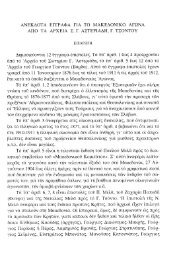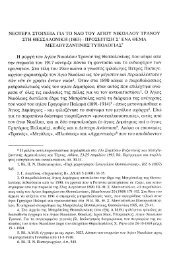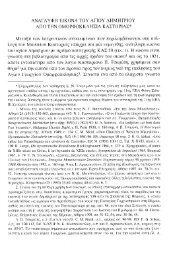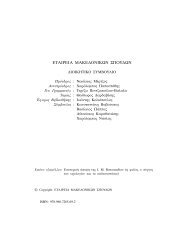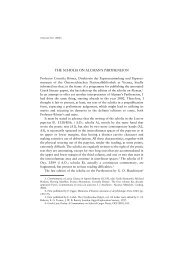ANA>KAOH ME>OBYZANTINOY NAOY >TO >I>ANI KOZANH:. NEA ...
ANA>KAOH ME>OBYZANTINOY NAOY >TO >I>ANI KOZANH:. NEA ...
ANA>KAOH ME>OBYZANTINOY NAOY >TO >I>ANI KOZANH:. NEA ...
You also want an ePaper? Increase the reach of your titles
YUMPU automatically turns print PDFs into web optimized ePapers that Google loves.
SUMMARY<br />
Antonios Petkos, Excavation of a Middle Byzantine Church at Sisani near<br />
Kozani. l',lew Int'ormation on the Diocese of Sisanion.<br />
The church examined in this article is built on the ruins of an earlier<br />
building (5th-6th cent.) and, despite its fragmentary state of preservation, in<br />
plan it consists of a cross-in-square structure set within a long rectangular<br />
three-aisled basilica. It contains archaic features in the form of the semicircular<br />
built synf hronon which was uncovered in the sanctuary and the typology<br />
ol the bipartite parabemata.<br />
The mural decoration which survives in the sanctuary and the prothesis, as<br />
well as a series of small glazed tiles with engraved representations, can be<br />
attributed to the time of the church's foundation. On the basis of the typology<br />
of the church, the construction technique, the surviving mural decoration, the<br />
pottery discovered in the fill, the glazed clay tiles and numerous fragments of<br />
wall-paintings, the structure must date to the l2th century, or even the 1lth.<br />
The church was destroyed by a violent natural cause, probably an earthquake,<br />
in the first half of the 13th century at the latest, and the remains were<br />
reused to create a cross-in-square church on the site of the old basilica,<br />
although there is no firm evidence for the existence of a dome. Notable features<br />
from this period are the opus sectile marble flooring in front of the<br />
sanctuary and the new extensive wall-paintings in the naos and the narthex.<br />
On the evidence of the bold traces of fire on the floor of the church,<br />
another disaster must have taken place at some time before the beginning of<br />
the 15th century.<br />
The Byzantine name of the church that has been uncovered remains<br />
unknown. However, a representation on the nalTow west side of the south pier<br />
ol'thc sanctuary, which depicts the founder-bishop kneeling before the Virgin<br />
enthroned, shows that it was an episcopal church and dedicated to the Panaghia.<br />
Given the fact that the church lies immediately next to the present-day<br />
Monastery of the Panaghia, it would be reasonable to assume that it constitutes<br />
the original church of the latter.<br />
The value of the new find lies in its rare architectural type, its mural<br />
decoration, and the fact that it marks the existence of Byzantine Sisanioupolis<br />
('/), which was very probably built between the old monasteries of St. De-<br />
metrius and the Panaghia.



